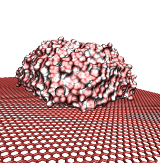The Professor of Thermodynamics and Fluid Mechanics at the University of Strathclyde, Jason Reese, explains the potential role played by carbon nanotubes (CNTs) in water desalination. Reese believes that CNTs will meet the demands of the ever-increasing global population for potable water.
Reese and his research team have examined CNTs, which include multiple sheets of carbon of one-atom thickness, rolled in the form of cylinders The researchers studied CNTs with the help of computer simulations and concluded that it could be used to convert plentiful seawater into potable water.
 Molecular Simulation of water droplet settling on graphene sheet
Molecular Simulation of water droplet settling on graphene sheet
The usual method used for water purification is based on the process of osmosis. In this process, water moves from a lower concentration area through a permeable membrane to a higher concentration area. Reese's method utilizes the principle of reverse osmosis.
According to the existing method of desalination using reverse osmosis, sea water and fresh water are separated by a permeable membrane and the sea water is subjected to high pressure and moves into the fresh water leaving the salt particles behind.
It was observed that the energy and cost involved for carrying out the process of desalination can be significantly reduced as Reese’s team expected CNTs to feature 20 times more water permeability when compared to existing reverse-osmosis membranes. CNTs are also effective for resisting salt ions as it is possible to combine it with certain chemical groups to perform a particular “gatekeeper” function.
According to Reese, reverse osmosis desalination combines increased water-transport rates with effective salt-ion rejection. Even though several questions remain unanswered, it is quite clear that CNT membranes will help in transforming the water desalination and water purification process.